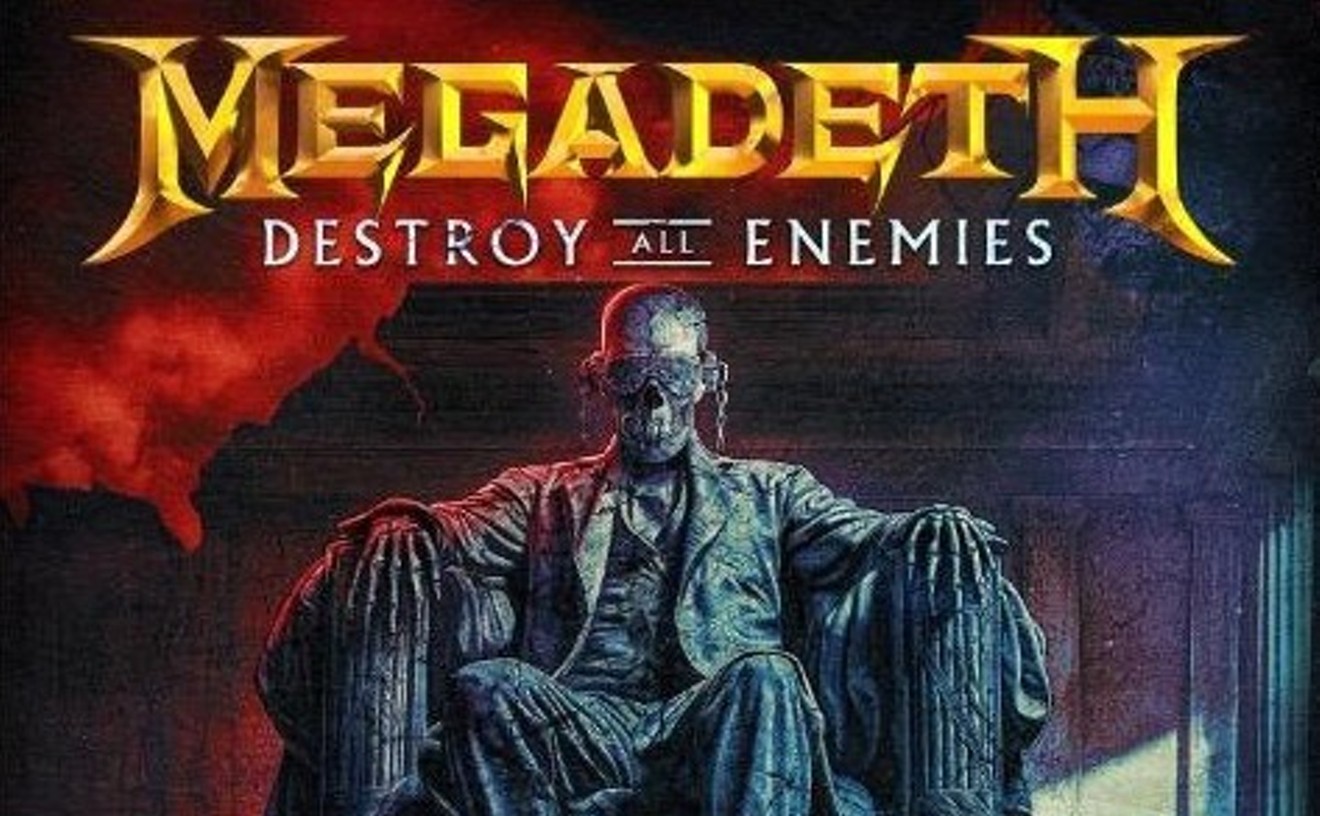"I don't really care anymore. I'd say as a whole there's more overtly conscious messages in the new songs. It's the first time I've had the courage to say something socially aware, without being afraid to sound like a hippie or a freak," he offers with a slight hint of exasperation. "It's part of me, and I can't ignore it."
The comments come amid discussion of the impending release of Sonoran Hope and Madness, the sophomore album from Roger Clyne and the Peacemakers and a follow-up to 1999's studio effort Honky Tonk Union (the group also released a live companion disc, Reel to Real).
This week the band prepares a final sequence for mastering and completes artwork for the album, which has been the group's main focus since the beginning of the year.
The bulk of the 10-song disc consists of material Clyne penned during the band's touring hiatus last fall. After six weeks of preproduction in April, the Peacemakers convened at bassist Danny White's new Formula One studio, recording and mixing for much of May and June.
The record had originally been intended as a live-in-the-studio affair, "but some of the arrangements and some of the parts weren't quite ready at that point," says Clyne. "So we ended up keeping the rhythm tracks and a few of the guitar tracks and just did the rest in a traditional studio style."
Significantly, the album finds Clyne easing a bit more comfortably into the role of leading a combo that bears his name. The title and cover of Honky Tonk Union (featuring Clyne clad in 10-gallon hat and boots) caused many to view it as a strident departure from the frantic post-punk of his former group, the Refreshments. And although HTU cuts like "Beautiful Disaster" and "Tow Chain" wouldn't have seemed out of place on either Fizzy Fuzzy Big and Buzzy or Bottle and the Fresh Horses, fans and critics alike were quick to recategorize Clyne's muse.
"Just by the nature of the term, we got called 'Americana' on the last record. It's not a moniker that I dislike. But I don't think it necessarily fits us," says Clyne. "Once you add anything vaguely country, or the idea of ruralism into rock 'n' roll, people want to jump on that."
As for the new effort, Clyne claims he wasn't looking to push the album in any particular stylistic direction, but rather decided to let it develop more organically.
"I wanted to make a record that would define its own space within the roots-rock genre. [Hope and Madness] is a rock record with almost, like, folk messages," he says.
"It incorporates an indigenous feel also. There's a lot of nylon string guitar, a lot of Latin percussion. It's a Sonoran Desert-feeling record. I don't shy away from that at all. I actually want to embrace it."
More notable is the overall sonic quality of Hope and Madness. While Honky Tonk Union was primarily recorded piecemeal at drummer P.H. Naffah's small home studio, the new record benefits from the more elaborate space and equipment found at Formula One. White's studio boasts an A Range board from London's famed Trident studios -- the same one used to record the likes of Queen, the Kinks and the Rolling Stones, among others. Similarly, the production -- jointly credited to Clyne, White and Naffah -- seems to have evolved beyond HTU's somewhat pensive and obviously homemade aesthetic.
"From a production standpoint, I know what I want to hear, and Danny and P.H. are really good at finding those sounds," says Clyne. "And recording at [Formula One] was an ideal situation, since we had the time and equipment to get things sounding the way we wanted."
But the singer insists that it was another factor -- namely the band's 18 months of almost nonstop touring -- responsible for the marked improvement over the previous album.
"The last record was done before we really even had the band together," says Clyne. "This one feels more cohesive. We've certainly developed a lot of chemistry since then. We've been together as a band for two and a half years now. And touring a lot was a good birth for the record. Things really started to jell in the studio because of that."
That chemistry is especially noticeable in the work of guitarists Steve Larson and Scott Johnson. The players' work runs the gamut from the former's crunchy country chords and aggressive slidework to the latter's jazzy fills and sharp pop touches. Their disparate styles weave together throughout to keep the textures interesting even on familiar-sounding fare like the title track.
Elsewhere, Naffah -- one of the Valley's more forceful trapsmen -- expands his range, incorporating subtle and tasteful percussion touches on a handful of cuts. Meanwhile, Clyne seems eager to return his foot to the throttle, forsaking the restrained vocal approach he took on HTU, and lending a more urgent quality to the material.
Of greater note, to Clyne, anyway, is the shift -- both lyrically and thematically -- in the songwriting.
"At this point, I'm not afraid to write a lyric like 'Life is grand/Love is real/And beauty is everywhere.' I wrote that and it came naturally to me. When I thought about putting it on a record, I was a little afraid of it," says Clyne. "But then I thought, 'Fuck it. Who cares?' And if somebody doesn't dig it, I hope they don't make it my problem.
"There's almost some protest songs on there," he adds. "Lyrically, it's the deepest and most soulful record I've written. There are definitely some fun spots on it, but there's some implicit criticism, and the audience will have to determine what it means to them."
The group -- which has maintained a regular local concert schedule in 2001 -- has previewed only about half of the new material in its sets. Among the familiar titles are the twang romp "Bury My Heart at the Trailer Park," the mournful "Ashes of San Miguel," and the twisting narrative "The Ballad of Lupe Montosa." Other standouts from the new record include "Sleep Like a Baby," a rocking-chair country number replete with banjo, which plays like a lost Glen Campbell cut -- a merger of "Gentle on My Mind" and "Southern Nights." Most of the songs, however, rely on a beefier approach, like the insistent Cheap Trick-influenced riff that carries "Mile High and Risin'." In fact, much of the album -- from the white soul backing on "Smaller and Better Things" to the boogie-beat of "Colorblind" -- is wrapped in thick swathes of classic rock.
Another long stretch of roadwork in support of the record is planned, beginning with a month's worth of tune-up dates starting in late August. Like the band's previous efforts, Hope and Madness will be self-released on its own Emma Java imprint. Though nothing has been confirmed, the group hopes to have the record out in the final week of September, in order to follow it up with a CD release concert at the Mesa Amphitheatre during the first weekend in October.
While HTU sold about 12,000 copies and Reel to Real logged about half that number, Clyne says his expectations for the new album won't rest on the ringing of cash registers.
"The most exciting thing for me is not record sales but the way our audience has been building live across the country. We've gone from playing to like 20 people in El Paso to selling out 600-seaters like Martyrs in Chicago -- without the benefit of radio play."
With an equally strong sense of satisfaction, Clyne notes that by the time the touring cycle for the new record is complete, the Peacemakers will have been together longer than the Refreshments.
"This is the band that's got the right connection and chemistry. I'm more excited about this [record] than I've ever been about anything I've done," he enthuses. "I know every artist says that about every record they put out, but I don't give a damn. It's really what I think. I can't wait to get it out."
Roger Clyne and P.H. Naffah are scheduled to perform an acoustic happy hour set on Tuesday, July 24, at Nita's Hideaway in Tempe. Showtime is 6 p.m. Roger Clyne and the Peacemakers are scheduled to perform on Saturday, July 28, at the Bash on Ash in Tempe. Showtime is 9 p.m.
Highway to Hellbilly: Local alt-country fans are in for a treat this weekend as a handful of the Valley's best twang-core acts takes the stage at the first Hellbilly Hootenanny 2001. The event, presented by Zia Record Exchange, features Truckers on Speed, Chicken, and Juarez. The show is set for Friday, July 20, at Nita's Hideaway in Tempe. Showtime is 9 p.m.
Nick at Nite: Texas bluesman Nick Curran has been making his presence felt in town with a string of much-talked-about club appearances. This week, Curran makes another trip back to the Valley for a two-night stand at the Rhythm Room. The dates are set for Friday, July 20, and Saturday, July 21. The fresh-faced guitarist/singer -- who began his career backing rockabilly cats Ronnie Dawson and Kim Lenz -- has earned reams of praise and comparisons to T-Bone Walker for his fluid fretwork, and Big Joe Turner for his impassioned vocals. Curran and his band, the Nitelifes, are touring in support of their second effort, the just-released Nitelife Boogie, available from the Texas Jamboree label. Both shows begin at 9 p.m.









